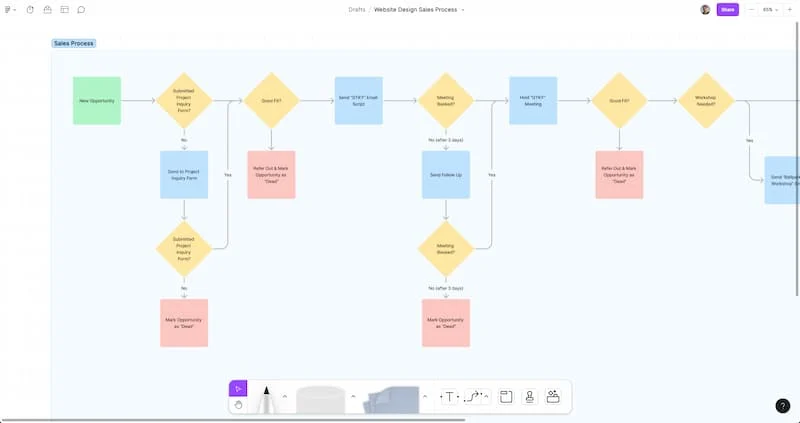I recently shared my move to a paid discovery model and got responses from people who do discovery after the project starts (or not at all) and are interested in a paid discovery model, but afraid they’ll get pushback trying to charge for it up-front.
Here’s how I see it….
The first thing a client wants is a price.
You cannot accurately quote a project without knowing the full scope of work.
To have a proper scope of work you need to know the following:
- Overall project goals and objectives.
- Key performance indicators (KPIs) to measure success.
- Understanding of the target audience and user personas.
- Competitive analysis, including what the competition is doing and how to differentiate.
- Legal requirements, compliance standards, and data protection considerations.
- Integration with other marketing efforts and how the website fits into the broader marketing strategy.
- Ongoing digital strategy post-launch, including content, SEO, and social media plans.
- Required technology stack and software tools.
- Website functionalities needed to meet objectives.
- Content management system (CMS) preferences.
- Third-party integrations (e.g., CRM, e-commerce platforms, social media feeds).
- Accessibility standards and inclusivity considerations.
- Security measures and protocols to be implemented.
- Inventory of existing digital assets and their quality assessment.
- Content that needs to be tweaked or updated.
- New assets to be created from scratch and responsibility for creation (e.g., text content, images, videos, infographics).
- Content strategy, including voice, tone, and messaging guidelines.
- Site structure, navigation, and user flow planning.
- Design and User Experience (UX)
- Brand guidelines and visual identity (colors, fonts, logos).
- Wireframes and design mockups to visualize the site layout.
- User experience (UX) design considerations and principles.
- User interface (UI) design specifics for interactive elements.
- Front-end and back-end development requirements.
- Database architecture and management.
- Performance optimization and loading speed targets.
- SEO best practices and strategies for implementation.
- Quality assurance and testing phases (e.g., functional, compatibility, performance tests).
- Feedback and revision cycles planned.
- Hosting requirements and deployment plans.
- Training for clients or team members on CMS or website management.
- Maintenance, support, and update strategy.
- Post-launch analytics and performance monitoring.
- Project timeline, milestones, and delivery deadlines.
- Budget constraints and billing arrangements.
- Communication plan and project management tools.
- Risk management and contingency planning.
I’ve yet to have a client walk in my door with all of that information already completely mapped out and organized on a silver platter.
So — someone’s gotta figure it out.
On a simple site you may be able to do that in 4 hours. On a big project it could take 40+ hours.
No reasonable prospect would expect you to do 4 to 40 hours of work for free for them before they ever hire you. Some irrational ones might, but that’s a great way to filter out the people you’d never want to work with.
Of course, we don’t have to do discovery… A lot of agencies send a quote after a simple sales call.
With your experience you’ll be able to assume some things correctly, but thinking you’ll guess right on everything is a gamble that’s either arrogant or ignorant.
The consequences are both all too common and catastrophic for projects (and relationships):
- Scope Creep & Cost Overruns: Discovering mid-project that you made an incorrect assumption means that you need to go back to your client asking for more money. Think the pushback on discovery is bad? How about when they’re already thousands in and you need more money now — they’ll feel like you’re holding them at ransom.
That’s really uncomfortable, so many agencies will just eat the costs of the overruns, which isn’t a great way to build your business.
The result is that either your client spends more and resents you or you lose money on the project and resent your client. - Delays & Revisions: Ever had a project where you were in a cycle of endless revisions or waiting weeks (or months!) on content? That’s what happens when a detailed, clear, and agreed-upon plan wasn’t put in place before the project ever begins.
The result is an extended timeline that frustrates both you and your client (which costs both of you more money). - Fail to Meet Needs: In an effort of self-preservation, you may choose to just build the site you originally quoted (the “guess”) and ignore any of the incorrect assumptions you made — even when they’re evident. The result will be a website facade that is unlikely to achieve the goals your client came to you with.
If you’ve been doing this job for any length of time, you’ve had a client come to you with a relatively new site that needs to be completely redone — this is how that happens.
Sure, clients don’t want to pay for discovery when their options are pay or don’t pay — but that’s not the choice they are making. What they are deciding is whether they want to roll the dice or stack the deck.
“Give me six hours to chop down a tree and I will spend the first four sharpening the axe.”
Abraham Lincoln
Explaining the necessity and value of the discovery phase in these terms usually resonates well with prospects — especially those who are serious about their business. Discovery isn’t some ‘thing’ we do to try and upsell the client, it’s literally the foundation of every project.



